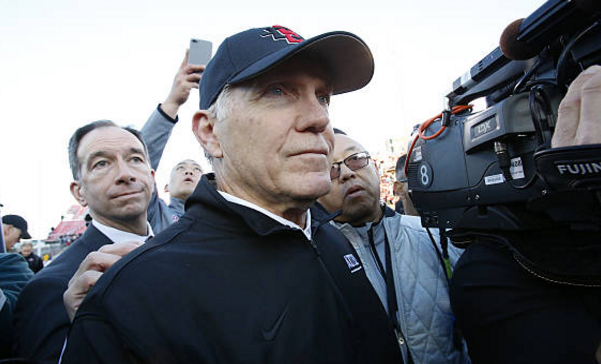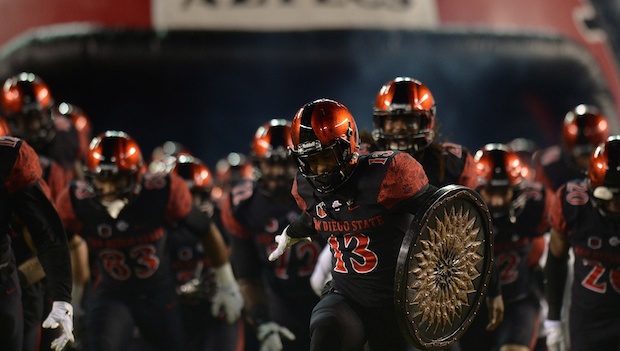Here’s a fun fact: The last time that the San Diego State Aztecs had a losing record was in 2010. Not since Brady Hoke’s first seasons have the Aztecs gone worse than 6-6. That is a level of consistency which is very rare in the Group of 5 conferences. Only Western Kentucky, Ohio, Toledo, Boise State, and Arkansas State have matched this feat.
In the Group of 5 conferences, consistency is very difficult to find. Turnover in coaches and less talent across the board, generally, means that teams are subject to big swings in success far more often. Individual players can make a bigger difference. Injuries can matter so much more. It says a lot when a program is able to sustain success — and that sustained success can have an impact on a national scale. This showed last year, when a second consecutive 10-win season finally earned the Aztecs a national ranking.
Consistently competing for division titles in Group of 5 conferences is both rare and commonplace at the same time. In fact, it is that rarity which makes it happen so often. In the MAC, it’s been Ohio and Toledo at the top for a while now. Toledo has miraculously never managed to win the MAC West in recent years (seriously, they’ve been the best team in the MAC for most of a decade and somehow have managed to lose the division to Northern Illinois or Western Michigan each year), but the Rockets are still consistently the class of the MAC. Boise State has dominated the WAC and then the Mountain West, basically since coming up from FCS. Arkansas State has been the cream of the Sun Belt for years.
When schools manage to build programs that can put themselves at the top of their respective conferences, unseating them is hard. Sure, there is some variation from year to year. Sometimes, another team can have a great season and launch a challenge. Sometimes, an off year opens the door. But once a Group of 5 team takes that step and starts backing up good seasons, it creates a cycle that builds off itself.
It’s hard to generate sustained recruiting success in the smaller conferences because of the extreme turnover in coaching. The good coaches recruit better, but they rarely last more than three years at a school before being snatched up by a bigger school. And if they’re not successful in recruiting, the school probably doesn’t have so much interest in keeping them.
This is why success on the football field in a Group of 5 conference can be so important. Players want to come to coaches who can recruit them, but they also want coaches who win. That’s why Toledo has one of the most talented programs in the MAC, year-in-year-out, even though coaches keep leaving. Once a good coach with a good core of players starts success, it can feed off itself even with coaching turnover.
How the Aztecs fit in
Which brings us to what San Diego State is doing. Brady Hoke turned this program around in just two years. He didn’t make any particular recruiting splash, but he managed to get the best out of his players so quickly that it drew the interest of Michigan. Rocky Long was selected as his replacement, and while some (myself included) were wary of the hire at the time, Long has absolutely proven to be the right guy for SDSU.
Long has also not made any major splash on the recruiting trail, which is why his success has come so quietly. He seems to be excelling at finding the right players for his system and coaching them up. The Aztecs even put three players in the NFL Draft this past year, no small feat for most Group of 5 teams. He is getting success out of these players, and it’s showing. San Diego State just won double-digit games in consecutive seasons for the first time since 1976-77. That still hasn’t made any real impact on the recruiting trail, as the Aztecs are still recruiting on par with Mountain West teams and other Group of 5 teams, not even on the level of Boise State or BYU.
What comes next?
Now, though, is the time for Long and SDSU to push this success nationally. The Aztecs return a lot from last year’s ranked team, including quarterback Christian Chapman and 1,000-yard rusher . Of course, the loss of Donnel Pumphrey will hurt, a lot, but San Diego State has shown in recent years that it can find itself good running backs. It is, frankly, an embarrassment of riches that returning a 1,000-yard rusher can be viewed as losing a lot. On the other side of the ball, the defense has been stout (at least by Mountain West standards) for a while now and should remain that way.
The schedule is a little tough this year, with two non-conference games against Pac-12 schools, as well as a cross-divisional game against Boise State. Still, the MWC West Division should pose no challengers to the Aztecs. A third consecutive trip to the conference championship game should be a minimum, and anything less than nine wins with this schedule would be extremely disappointing.
San Diego State has plenty of advantages that could make it a football powerhouse. It has some historic success, especially at running back. The program has been winning for over half a decade now, which should be a selling point to recruits and an inspiration to current players. The team gets to play its home games in an NFL-style stadium (the Chargers left Qualcomm when they moved back to Los Angeles), which should be a selling point to recruits. The school is located in southern California, an excellent place to both recruit and to convince kids to want to go to school.
The Aztecs have built their success of the last two years on being in one of the weaker divisions in FBS. Other than SDSU, the MWC West is a mess. It is possible that SDSU’s success was really only built off the back of playing in a poor division. Even if that’s true, though, it takes a good amount of talent to be able to dominate even a bad division. The Aztecs have certainly been dominant, and they are giving no indication that it will let up this year. Whether they remain just a conference power or can be relevant on a national scale is a question that only time will answer. Of course, that time might not be so far away. Stanford visits Qualcomm in Week 3–that’s when we’ll see if the Aztecs are ready to make a national splash this year.










You do realize that Qualcomm is likely going away, don’t you? Selling recruits on the coolness of playing on a glorified soccer field may not be quite as easy.
Qualcomm will be there for 2, probably 4 years, at which time SDSU will have built its football focused stadium on a portion of the existing Qualcomm site. There won’t be a soccer stadium built as Sucker City is all but dead.
Also 2009 is the last time SDSU had a losing season at 4-8.
https://www.sports-reference.com/cfb/schools/san-diego-state/